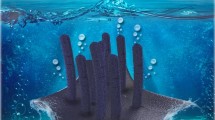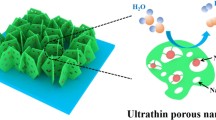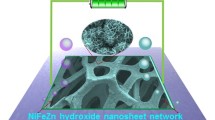Abstract
Doping hetero-atoms into non-noble metal phosphides, which is a better strategy for enhancement of electrocatalytic activity due to regulation of the electronic structure of catalysts. Herein, the F-doped CoP/Ni2P nanoarrays grown on nickel foam (NF) was fabricated by facile method as a self-supported electrode for hydrogen evolution reaction (HER), and this nanowires structure provide large specific surface area and more active sites. Additionally, the synergy effect between CoP and Ni2P can accelerate the electron transfer rate and increase the reaction rate. Moreover, the addition of strongly electronegative fluorine (F) can cause significant changes in electronic structure and enhance electrocatalytic HER performance. Therefore, the fabricated F-CoP/Ni2P/NF catalyst exhibits excellent HER activity in both alkaline and acidic electrolyte with a lower overpotential of 99 mV and 106 mV at a current density of 10 mA cm−2 and good durability. Hence, this work provides a simple method for exploring heteroatoms-regulated non-precious metal catalysts, which can be used to develop more efficient HER catalysts for water splitting.
Graphical abstract
The self-supported fluorine-doped CoP/Ni2P nanowire array was prepared as efficient and stable electrocatalyst for hydrogen evolution reaction in both alkaline and acidic media.






Similar content being viewed by others
Data and code availability
Data available on request from the authors.
References
Zhao GQ, Rui K, Dou SX, Sun WP (2018) Heterostructures for electrochemical hydrogen evolution reaction: a review. Adv Funct Mater 28(43):1803291
You B, Tang MT, Tsai C, Abild-Pedersen F, Zheng XL, Li H (2019) Enhancing electrocatalytic water splitting by strain engineering. Adv Mater 31(17):1807001
Sun HM, Yan ZH, Liu FM, Xu WC, Cheng FY, Chen J (2020) Self-supported transition-metal-based electrocatalysts for hydrogen and oxygen evolution. Adv Mater 32(3):1806326
Xiong P, Zhang XY, Wan H, Wang SJ, Zhao YF, Zhang JQ (2019) Interface modulation of two-dimensional superlattices for efficient overall water splitting. Nano Lett 19(7):4518–4526
Qu YT, Chen BX, Li ZJ, Duan XZ, Wang LG, Lin Y, Yuan TW, Zhou FY et al (2019) Thermal emitting strategy to synthesize atomically dispersed Pt metal sites from bulk Pt metal. J Am Chem Soc 141:4505–4509
Over H (2021) Fundamental studies of planar single-crystalline oxide model electrodes (RuO2, IrO2) for acidic water splitting. ACS Catal 11(14):8848–8871
Shanker GS, Ogale S (2021) Faceted colloidal metallic Ni3N nanocrystals: size-controlled solution-phase synthesis and electrochemical overall water splitting. ACS Appl Energy Mater 4(3):2165–2173
Hu WJ, Shi Q, Chen ZJ, Yin H, Zhong HF, Wang P (2021) Co2N/Co2Mo3O8 heterostructure as a highly active electrocatalyst for an alkaline hydrogen evolution reaction. ACS Appl Mater Interfaces 13(7):8337–8343
Hu Y, Yu B, Ramadoss M, Li WX, Yang DX, Wang B (2019) Scalable synthesis of heterogeneous W–W2C nanoparticle-embedded CNT networks for boosted hydrogen evolution reaction in both acidic and alkaline media. ACS Sustain Chem Eng 7(11):10016–10024
Lu XF, Yu L, Zhang JT, Lou XW (2019) Ultrafine dual-phased carbide nanocrystals confined in porous nitrogen-doped carbon dodecahedrons for efficient hydrogen evolution reaction. Adv Mater 31(30):1900699
Wang GX, Chen W, Chen GL, Huang J, Song CS, Chen DL, Du Y, Li CR, Ostrikov KK (2020) Trimetallic Mo–Ni–Co selenides nanorod electrocatalysts for highly-efficient and ultra-stable hydrogen evolution. Nano Energy 71:104637
Zhou YN, Ma Y, Feng L, Zhao J, Tong Z, Dong B, Zhu YR, Wang L, Liu CG, Chai YM (2020) Optimized Mo-doped cobalt selenides coupled carbon nanospheres for efficient hydrogen evolution. Appl Surf Sci 531:147404
Zhou YN, Zhu YR, Chen XY, Dong B, Li QZ, Chai YM (2021) Carbon-based transition metal sulfides/selenides nanostructures for electrocatalytic water splitting. J Alloy Compd 852:156810
Gautam J, Liu Y, Gu J, Ma ZY, Zha JJ, Dahal B, Zhang LN, Chishti AN, Ni LB, Diao GW, Wei YG (2021) Fabrication of polyoxometalate anchored zinc cobalt sulfide nanowires as a remarkable bifunctional electrocatalyst for overall water splitting. Adv Funct Mater 31:2106147
Liu QN, Hu Z, Liang YR, Li L, Zou C, Jin HL, Wang S, Lu HM, Gu QF, Chou SL, Liu Y, Dou SX (2020) Facile synthesis of hierarchical hollow CoP@C composites with superior performance for sodium and potassium storage. Angew Chem 59(13):5197–5202
Liu JL, Gao Y, Tang XX, Zhan K, Zhao B, Xia BY, Yan Y (2020) Metal-organic framework-derived hierarchical ultrathin CoP nanosheets for overall water splitting. J Mater Chem A 8(37):19254–19261
Li Y, Dong ZH, Jiao LF (2019) Multifunctional transition metal-based phosphides in energy-related electrocatalysis. Adv Energy Mater 10(11):1902104
Wu Y, Li XM, Zhao H, Yao FB, Cao J, Chen Z, Huang XD, Wang DB, Yang Q (2021) Recent advances in transition metal carbides and nitrides (MXenes): characteristics, environmental remediation and challenges. Chem Eng J 418:129296
Li FF, Gao JF, He ZH, Kong LB (2021) Crystal phase-controlled synthesis of the CoP@Co2P heterostructure with 3D nanowire networks for high-performance Li-ion capacitor applications. ACS Appl Mater Interfaces 13(8):10071–10088
Ge J, Zhang W, Tu J, Xia T, Chen SP, Xie G (2020) Suppressed Jahn-Teller distortion in MnCo2O4@Ni2P heterostructures to promote the overall water splitting. Small 16(34):2001856
Lv XW, Xu WS, Tian WW, Wang HY, Yuan ZY (2021) Activity promotion of core and shell in multifunctional core-shell Co2P@NC electrocatalyst by secondary metal doping for water electrolysis and Zn-Air batteries. Small 17(38):2101856
Yang L, Liu RM, Jiao LF (2020) Electronic redistribution: construction and modulation of interface engineering on CoP for enhancing overall water splitting. Adv Funct Mater 30:1909618
Yu HB, Qi LL, Hu Y, Qu Y, Yan PX, Isimjan TT, Yang XL (2021) Nanowire-structured FeP-CoP arrays as highly active and stable bifunctional electrocatalyst synergistically promoting high-current overall water splitting. J Colloid Interface Sci 600:811–819
Mei Y, Li HW, Cong YK, Huang SS, Xu W, Qian JJ, Li TT (2021) Self-supported N-doped carbon@NiXCo2-XP core-shell nanorod arrays on 3D Ni foam for boosted hydrogen evolution reaction. Int J Hydrog Energy 46:36046–36055
Pan Y, Sun KA, Liu SJ, Cao X, Wu KL, Cheong WC, Chen Z, Wang Y et al (2018) Core-shell ZIF-8@ZIF-67-derived CoP nanoparticle-embedded N-doped carbon nanotube hollow polyhedron for efficient overall water splitting. J Am Chem Soc 140(7):2610–2618
Huang C, Qin P, Luo Y, Ruan QD, Liu LL, Wu YZ, Li QW, Xu Y, Liu RG, Chu PK (2022) Recent progress and perspective of cobalt-based catalysts for water splitting: design and nanoarchitectonics. Mater Today Energy 23:100911
Li Z, Feng H, Song M, He C, Zhuang W, Tian L (2021) Advances in CoP electrocatalysts for water splitting. Mater Today Energy 20:100698
Yan L, Zhao SZ, Li YY, Zhang B, Zhu JL, Liu ZG, Yuan XX, Yu JL, Zhang HY, Shen PK (2019) Hierarchical cobalt phosphide hollow nanoboxes as high performance bifunctional electrocatalysts for overall water splitting. Mater Today Energy 12:443–452
Wang ZH, Wei CY, Zhu XB, Wang XB, He JL, Zhao Y (2021) A hierarchical carbon nanotube forest supported metal phosphide electrode for efficient overall water splitting. J Mater Chem A 9(2):1150–1158
Zhang HJ, Maijenburg AW, Li XP, Schweizer SL (2020) Bifunctional heterostructured transition metal phosphides for efficient electrochemical water splitting. Adv Funct Mater 30(34):2003261
Fan S, Zhang J, Wu QY, Huang SZ, Zheng JL, Kong DZ, Chen S, Wang Y et al (2020) Morphological and electronic dual regulation of cobalt nickel bimetal phosphide heterostructures inducing high water-splitting performance. J Phys Chem Lett 11(10):3911–3919
Liu H, Liu ZH, Wang Y, Zhang JQ, Yang ZX, Zhao HuH, QS, Ning H, Zhi LJ, Wu MB, (2021) Carbon dots-oriented synthesis of fungus-like CoP microspheres as a bifunctional electrocatalyst for efficient overall water splitting. Carbon 182:327–334
Huang FH, Wang JZ, Wang M, Zhang C, Xue YA, Liu J, Xu T (2021) Core-shell Ni2P@CoP nanoarrays supported on NF as a highly efficient electrocatalyst for hydrogen evolution reaction. Colloid Surface A 623:12652
Zhang YN, Li L, Chen JL, Ma YM, Yang XW (2021) MOFs template derived Co/Fe binary phosphide nanocomposite embedded in ternary-doped carbon matrix for efficient water splitting. Ceram Int 47(9):12843–12850
Guo JJ, Huo JJ, Liu Y, Wu WJ, Wang Y, Wu MH, Liu H, Wang GX (2017) Defect chemistry of nonprecious-metal electrocatalysts for oxygen reactions. Adv Mater 29(9):1606459
Xu K, Sun YQ, Li XL, Zhao ZH, Zhang YQ, Li CC, Fan HJ (2020) Fluorine-induced dual defects in cobalt phosphide nanosheets enhance hydrogen evolution reaction activity. ACS Mater Lett 2(7):736–743
Sim Y, Kim SJ, Janani G, Chae Y, Surendran S, Kim H, Yoo S, Seok DC et al (2020) The synergistic effect of nitrogen and fluorine Co-doping in graphene quantum dot catalysts for full water splitting and supercapacitor. Appl Surf Sci 507:145157
Xu TT, Yang L, Li J, Usoltseva N, An V, Jin X, Zhang C, Zhang XL, Liu BD (2021) NH4F-induced morphology control of CoP nanostructures to enhance the hydrogen evolution reaction. Inorg Chem 60(14):10781–10790
Kang QL, Li MY, Shi JW, Lu QY, Gao F (2020) A universal strategy for carbon-supported transition metal phosphides as high-performance bifunctional electrocatalysts towards efficient overall water splitting. ACS Appl Mater Interfaces 12(17):19447–19456
Tan QR, Xiao R, Yao XC, Xiong TZ, Li JQ, Hu YW, Huang YC, Balogun MS (2021) Non-oxygen anion-regulated in situ cobalt based heterojunctions for active alkaline hydrogen evolution catalysis. Chem Eng J 433:133514
Zhang JT, Zhang Z, Ji YF, Yang JD, Fan K, Ma XZ, Wang C, Shu RY, Chen Y (2021) Surface engineering induced hierarchical porous Ni12P5-Ni2P polymorphs catalyst for efficient wide pH hydrogen production. Appl Catal B Environ 282:119609
Wu LB, Yu L, Zhang FH, McElhenny B, Luo D, Karim A, Chen S, Ren ZF (2021) Heterogeneous bimetallic phosphide Ni2P-Fe2P as an efficient bifunctional catalyst for water/seawater splitting. Adv Funct Mater 31(1):2006484
Guo JY, Wang BZ, Yang DD, Wan ZX, Yan PX, Tian JN, Isimjan TT, Yang XL (2020) Rugae-like Ni2P-CoP nanoarrays as a bi-functional catalyst for hydrogen generation: NaBH4 hydrolysis and water reduction. Appl Catal B Environ 265:118584
Lu ZJ, Cao YL, Xie J, Hu JD, Wang K, Jia DAZ (2020) Construction of Co2P/CoP@Co@NCNT rich-interface to synergistically promote overall water splitting. Chem Eng J 430:132877
Han XY, Li J, Lu JL, Luo S, Wan J, Li BX, Hu CG, Cheng XL (2021) High mass-loading NiCo-LDH nanosheet arrays grown on carbon cloth by electrodeposition for excellent electrochemical energy storage. Nano Energy 86:106079
Zhao DP, Dai MZ, Zhao Y, Liu HQ, Liu Y, Wu X (2020) Improving electrocatalytic activities of FeCo2O4@FeCo2S4@PPy electrodes by surface/interface regulation. Nano Energy 72:104715
Mo QJ, Zhang WB, He LQ, Yu X, Gao QS (2019) Bimetallic Ni2-xCoxP/N-doped carbon nanofibers: solid-solution-alloy engineering toward efficient hydrogen evolution. Appl Catal B Environ 244:620–627
Song LL, Wang QQ, Ye XY, Yang F, Wang L, Wu Y, Xu F, Wang YQ (2021) Sulfide-fixed intrinsic porous NiCoP for boosting high capacitance and long-term stability. ACS Mater Lett 3(7):1016–1024
Cheng QX, Chen YY, Lin XM, Liu JC, Yuan ZZ, Cai YP (2020) Hybrid cobalt(II) fluoride derived from a bimetallic zeolitic imidazolate framework as a high-performance cathode for lithium-ion batteries. J Phys Chem C 124(16):8624–8632
He WJ, Han LL, Hao QY, Zheng XR, Li Y, Zhang J, Liu CC, Liu H, Xin HLL (2019) Fluorine-anion-modulated electron structure of nickel sulfide nanosheet arrays for alkaline hydrogen evolution. ACS Energy Lett 4(12):2905–2912
Yao J, Zhang MY, Ma XZ, Xu LL, Gao F, Xiao JP, Gao H (2022) Interfacial electronic modulation of CoP-CoO p-p type heterojunction for enhancing oxygen evolution reaction. J Colloid Interface Sci 607:1343–1352
Acknowledgments
This work was financially supported by the National Natural Science Foundation of China (Grant No. 52063026 and 51872245), the Natural Science Foundation of Gansu Province of China (20JR10RA087) and the Scientific Research Ability Promotion Program of Young Teachers of Northwest Normal University (NWNU-LKQN-18-18).
Author information
Authors and Affiliations
Corresponding author
Ethics declarations
Conflict of interest
The authors declare that they have no conflict of interest.
Ethical approval
is not involved in the manuscript.
Additional information
Handling Editor: Pedro Camargo.
Publisher's Note
Springer Nature remains neutral with regard to jurisdictional claims in published maps and institutional affiliations.
Supplementary Information
Below is the link to the electronic supplementary material.
Rights and permissions
Springer Nature or its licensor (e.g. a society or other partner) holds exclusive rights to this article under a publishing agreement with the author(s) or other rightsholder(s); author self-archiving of the accepted manuscript version of this article is solely governed by the terms of such publishing agreement and applicable law.
About this article
Cite this article
Yang, Y., Kang, M., Guo, X. et al. Fluorine-regulated binary cobalt nickel phosphides nanoarrays on nickel foam for enhanced hydrogen evolution reaction. J Mater Sci 58, 6407–6418 (2023). https://doi.org/10.1007/s10853-023-08423-5
Received:
Accepted:
Published:
Issue Date:
DOI: https://doi.org/10.1007/s10853-023-08423-5




